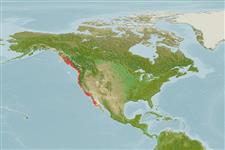Environment: milieu / climate zone / depth range / distribution range
Écologie
marin démersal; profondeur 0 - 200 m (Ref. 2850). Subtropical; 58°N - 26°N, 137°W - 112°W
Eastern Pacific: Sitka, southeastern Alaska to Punta Abrejos, central Baja California, Mexico.
Taille / Poids / Âge
Maturity: Lm ? range ? - ? cm
Max length : 99.0 cm TL mâle / non sexé; (Ref. 2850); poids max. publié: 14.0 kg (Ref. 27436); âge max. reporté: 13 années (Ref. 56049)
Description synthétique
Clés d'identification | Morphologie | Morphométrie
Épines dorsales (Total) : 8 - 12; Rayons mous dorsaux (Total) : 15 - 18; Épines anales: 0; Rayons mous anaux: 11 - 13; Vertèbres: 35. Caudal fin barely rounded.
Inhabits rocky, sandy and muddy bottoms as well as kelp beds (Ref. 4925). Adults and juveniles feed on crustaceans, fishes and mollusks (Ref. 6885). Commonly captured by sport fishers (from shore, boats or piers) and by scuba divers (Ref. 2850). Flesh is good eating but eggs are poisonous and will make humans violently ill (Ref. 13513).
Eschmeyer, W.N., E.S. Herald and H. Hammann, 1983. A field guide to Pacific coast fishes of North America. Boston (MA, USA): Houghton Mifflin Company. xii+336 p. (Ref. 2850)
Statut dans la liste rouge de l'IUCN (Ref. 130435: Version 2024-1)
Utilisations par l'homme
Pêcheries: commercial; pêche sportive: oui; Aquarium: Aquariums publics
Outils
Articles particuliers
Télécharger en XML
Sources Internet
Estimates based on models
Preferred temperature (Ref.
123201): 7.5 - 11.6, mean 8.9 °C (based on 40 cells).
Phylogenetic diversity index (Ref.
82804): PD
50 = 1.0000 [Uniqueness, from 0.5 = low to 2.0 = high].
Bayesian length-weight: a=0.00389 (0.00180 - 0.00842), b=3.12 (2.94 - 3.30), in cm total length, based on all LWR estimates for this body shape (Ref.
93245).
Niveau trophique (Ref.
69278): 3.6 ±0.47 se; based on food items.
Generation time: 3.2 ( na - na) years. Estimated as median ln(3)/K based on 1
growth studies.
Résilience (Ref.
120179): Milieu, temps minimum de doublement de population : 1,4 à 4,4 années (tm=3; tmax=13; K=0.3, Fec=40,000-90,000).
Prior r = 0.33, 95% CL = 0.22 - 0.50, Based on 4 full stock assessments.
Fishing Vulnerability (Ref.
59153): Moderate vulnerability (37 of 100).
Climate Vulnerability (Ref.
125649): Moderate vulnerability (44 of 100).
Nutrients (Ref.
124155): Calcium = 75.8 [30.9, 167.0] mg/100g; Iron = 0.974 [0.431, 2.041] mg/100g; Protein = 18.4 [16.2, 20.5] %; Omega3 = 0.314 [0.140, 0.892] g/100g; Selenium = 48.9 [24.8, 117.3] μg/100g; VitaminA = 6.13 [2.10, 17.38] μg/100g; Zinc = 0.592 [0.387, 0.936] mg/100g (wet weight);
